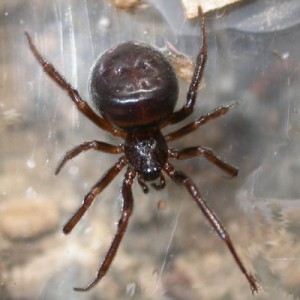Spider-Man, I made you!
It’s almost summer, and that means superheroes. A torrent of them, a plague of them! Not unlike the grim spider army that homeowners report to their local newscasters whenever they see something brown that skitters. This time there’s a big hairy blockbuster movie among the big hairy intruders: “The Amazing Spider-Man.” I’m not a comic book fan, so all this talk about a “reboot” leaves me cold (spiders, the real kind, shiver when you say “boot.”). It opens July 3, so I might as well let my online searches overflow with Andrew Garfield this, Emma Stone that, not to mention “Turn off the Dark” (the Broadway show), until the wires go back to their usual chatter about Invisible Spiders that stalk the unwary sleeper.
Still, I must take note of one rumored change in the Spider-Man backstory. You might recall that one character prominent in the Tobey Maguire version of the “Spider-Man” franchise was a spider. It bit Tobey and made him what he is. Apparently the spider was radioactive, which is one of those fun, wacky 1950s conceits that don’t really scan today … radioactivity leading in fact to death, not superpowers. At the start of that first film, which I saw in pursuit of a Big Dumb Summer Movie, the spider landed on Peter Parker and nipped him. The bite was just Method acting, but the spider was real. It was even wearing spider makeup and carrying a tiny Equity card. The actor was, however, false: a false black widow, or Steatoda grossa.
Fanboy rumor says this year’s Peter Parker gets endowed not by a radioactive spider bite but by something from a lab … genetic tinkering or some such. And I bet they don’t even use a live spider this time, computer graphics having progressed so far. Dang. One more out-of-work actor, and in this economy. Guess it’s back to the back lot for Steatoda grossa, which is probably where the spider wrangler for the 2002 movie found her in the first place.
This common species occupies the margin between medically significant spiders and the innocent, ain’t-hurt-nobody garden varieties. Steatoda grossa practically defines garden variety. The places she likes to live are all over the typical yard (basement, too). She hides under the terra cotta saucer, in the space between shed and fence, in a sawdusty nook by the car, perhaps in the finger of your garden glove—pretty much anywhere you might expect to see a black widow (Latrodectus), except she isn’t one. False widows seem to favor damper places than the true widow, such as the crawlspace under my house where moisture from the clothes drier lingers. Real widows, like Marilyn, like it hot. When I catch Steatoda she usually plays dead, which makes me feel bad, so I let her go, then she ever-so-slowly unshrivels and stumbles away.
Her coloration is variable but the ones I see most often are glossy dark brown with a pale dot or two on her dimpled abdomen. She (or her male counterpart) might be marbled like halvah. If you look close you see she has oddly glittering eyes, gleaming with Hollywood ambition. The posterior median ones, I think. They sparkle like flecks of glass in the flashlight beam—and not just from the front, like the usual spider eyeshine. (You don’t know about eyeshine?! One of the wonders of spider watching. More on that later, if I can get decent pictures.)
It’s funny how many people think any old brown spider is a recluse, but I can’t blame people for thinking Steatoda is a black widow; they are relatives, after all, in the big happy Theridiid family, and favor the same look and the same turf.
In Britain they go all barmy over a cousin called Steatoda nobilis, a mildly medically significant non-native creature that’s got everyone’s rugby shorts in a bunch. “The most venomous spider in Britain!” Oi, you’d think it was the Blitz. And most of the tabloid cases quote Wallace or Gromit saying, you guessed it, “Never saw the little bugger who bit me,” and even the visible buggers are usually identified by the nearest Cockney chimneysweep and not by anyone who’d actually know. Still, there are a few confirmed Steatoda bites here and there. This isn’t one of them (hint: Steatoda nobilis, like Peter Parker, lacks the power of invisibility).
After Steatoda grossa had her big moment in “Spider-Man,” lots of people were surprised to learn that the spider wasn’t computer-generated. An insect wrangler had supplied the false black widow and dolled her up in red and blue to make her look sinister. Although Steatoda has the right figure for the part (sleek, glossy, tapering, and can I mention Scarlett Johansson as the Black Widow here? No? Aw), she can’t do radioactive without having some work done. National Geographic ran a fun story about the bug boss who cast Steatoda for her big part.
You can induce Steatoda grossa to bite you, not that I have, using the technique of rolling over on her or trapping her in clothing. I’ve never found any indications that the bite is worse than a bee sting. This is the usual pain yardstick that’s meant to reassure people but kinda doesn’t, given how much we all enjoy being stung by bees. Reported symptoms include “blistering” and “malaise.” Once in a blue moon a bite creates significant medical problems, and at least one study has shown that antivenin developed for bites of the redback spider (Australia’s native widow) works for Steatoda as well. But you takes your chances: people have fatal anaphylactic reactions to antivenin, too.
The false widow is neither hero nor villain in her contacts with the human world, falling into the category of small animals that should be acknowledged but not feared. As with most spiders it’s quite obvious what kind of business she’s about: not stalking people (although do shake those garden gloves) or pursuing evildoers, but rather pursuing bugs for dinner, spinning her sloppy yet effective web, lying low, making more of her kind.
She doesn’t have any superpowers, and I do wonder why her bite made Peter Parker shoot silk out of his … wrists. Is the moviegoing public not ready for an anatomically correct Spider-Man? Bet Howard Stern could have fun with that.
Some relatives of the false black widow do have special talents beyond scaring British people. They can live together without killing each other. These are among the social spiders—like social butterflies, I guess, but with fangs and venom. Life in the spider colony is sure lively, what with prey-capture cooperation, shared egg-sitting, and occasional mass emigration. How they work it out is a mystery, though the uncommonness of this arrangement suggests to some scientists that pallin’ around with your fellow cannibals might not be the best idea for spiders in the long run.
As for long runs, let us prepare for a summer of super spiders and bats and men in black, leading perhaps to new impressions in the Hollywood Walk of Fame, though if there’s a spider there in the concrete you can guarantee it was stepped on. Fame is the ultimate false mistress, poor Steatoda grossa.

